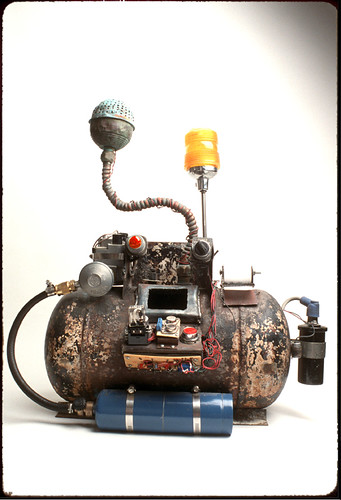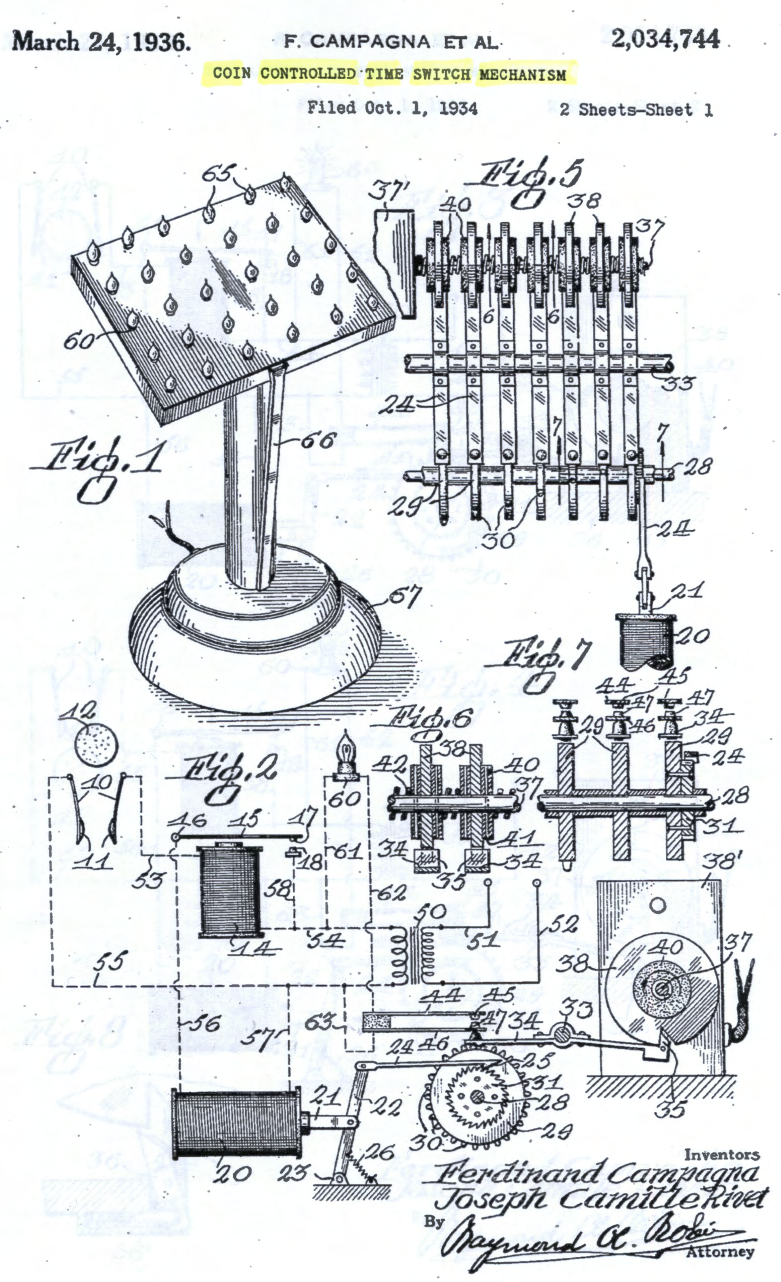 Anderson Blanton (anthropology), postdoctoral scholar at the Max Planck Institute for the Study of Religious and Ethnic Diversity, has spent the past several years researching how religious experience is shaped by media technologies and devotional objects. In a recent conversation with Onnesha Roychoudhuri, Blanton discusses how his interest in this topic developed, bureaucracy as a kind of faith, the sacralization of everyday objects, and the “quotidian robustness of religious practice.”
Anderson Blanton (anthropology), postdoctoral scholar at the Max Planck Institute for the Study of Religious and Ethnic Diversity, has spent the past several years researching how religious experience is shaped by media technologies and devotional objects. In a recent conversation with Onnesha Roychoudhuri, Blanton discusses how his interest in this topic developed, bureaucracy as a kind of faith, the sacralization of everyday objects, and the “quotidian robustness of religious practice.”
Onnesha Roychoudhuri: How did you first become interested in the materiality of prayer?
Anderson Blanton: I was conducting research on gospel radio: small independent radio stations broadcasting Pentecostal preaching and worship styles on the AM and FM dial. You can still hear it when you drive all over the country. I was also going out into the community, doing fieldwork in several different Christian and Pentecostal communities in North Carolina, Virginia, and West Virginia. This object called “the prayer cloth” kept coming up. It’s usually a small snippet of cloth, a piece of a rag, or even a handkerchief that’s been prayed upon. The Charismatic faithful perform what they call “the anointing,” which is either laying hands on the object during communal prayer, and/or the actual application of oil upon the fabric. After this communal consecration, the materialized prayer is distributed throughout the community for divine protection and to bring blessings—sometimes in the form of miraculous financial accumulation.
The prayer cloth kept popping up in all of these communities, and I realized it was much more important than the scanty references I’d come across in the literature. I began looking back into the early history of Pentecostalism, and I found that the prayer cloth was a crucial material relay in and thorough which communities of faith were formed and sustained. A chapter in my most recent book, Hittin’ the Prayer Bones: Materiality of Spirit in the Pentecostal South, is dedicated to an exploration of this consecrated rag.
OR: In your writing, you’ve tied the prayer cloth more broadly to this idea that we’ve historically overlooked the role of materiality in prayer. Before I called you, I looked up the definition for prayer in Merriam-Webster, which defines it as “an address, as a petition to God (or a god), in word or thought.” So there’s no reference to the object. What do you think we miss when we look at prayer primarily as an internal or intellectual behavior?
AB: That definition is based upon a very Protestant idea about “proper” prayer which imagined the practice of divine communication, whether it be word or thought, to be a spontaneous and improvisatory outpouring of the heart. While I think this is certainly a legitimate way in which one might approach the phenomenon of prayer, there are all kinds of political motives operating behind this definition. For example, this particular description of prayer was often mobilized as an implicit critique of Catholic recitational practice and the use of devotional objects such as prayer beads. So from the very get-go, Webster’s seemingly straightforward and taken for granted definition excludes all of the vibrant traditions that mobilize bodily techniques (breath, posture, manual gesture), colorful images, structures of repetition, and devotional objects in order to open a communicative space between the sacred and the everyday.
In many ways the history of Protestantism has been sustained by a struggle with materiality and the particular ways in which the spirit would manifest itself in the world. The definition for prayer that you mention had a very important impact when the academic disciplines of anthropology and religious studies were formulating categories to think about “religion,” both in terms of its history and its future. During this formation, these academic fields were trying to differentiate between older, more “primitive” forms of magic, and supposedly more abstract and modern forms of what they were calling “religion.” What is important to note in this historical sketch is the way in which prayer, as a category, became a crucial pivot upon which the academic study of religion turned. More specifically, much ink was spilled in an attempt to demarcate a clear boundary between magical incantation—with all its associated material objects and fixed bodily gestures—and the contingent act of prayer to an abstract and intellectualized deity. This formative demarcation was heavily politicized and animated by a specific Protestant idea of prayer. But it ended up, as so often happens, that these early formations and their political contexts faded into the background. Our average everyday understanding of prayer, both in the academy and on the street, is thus sustained by a repression that allows Webster’s definition of prayer as a spiritual act of vocal articulation or interior thought to persist.
The power and intellectual sedimentation of this definition is clearly demonstrated through the work of contemporary scholars of religion who take as their methodological starting point the idea that prayer is about an immaterial act of volition. While many of these studies are promising, it is interesting to note how they reproduce the Protestant narrative of prayer as a progressive abstraction from the magical material thing—be it the body, the object, or the technological apparatus—until it ends up being a kind of silent dialogue with an interior God. The Materiality of Prayer collection focuses on the material underbelly of prayer, demonstrating how the repressed thing not only animates pious practices in many religious traditions (including Protestantism!), but also how the renunciation of the object has fundamentally enlivened the academic study of religion.
OR: What happens when we expand the definition of prayer to make space for materiality? Do you then see prayer as a more broadly manifested thing? Can we see evidence of prayer in more secular or non-religious contexts?
AB: This is a wonderful question. When it comes to technology, we can see a kind of post-secular moment of prayer in the popular genres of horror and the uncanny. So many horror films nowadays feature a moment where there’s a premonition of something monstrous about to appear. I’m fascinated with how this presaging of terrible things to come is often registered by media technologies such as the camera or the cellular phone. So, for instance, in The Ring, the camera itself begins to register an anamorphotic distortion of the face that presages death. As an extension of our sensory faculties, technology itself begins to register the horrific presence of that which persists outside or beyond our ‘natural’ sensory capacities. Our contemporary fascination with genres of the uncanny can be seen as a kind of monstrous un-placeable prayer that is ‘voiced’ through the agency of a technological interface. In many contemporary horror films, the process of technological mediation opens a communicative relay between the everyday and an excessive beyond. In this way, to be frightened in a theatre is to be immersed in the terrible narrative progression of a post-secular prayer. As scholars of religion, I think we should attend closely to these uncanny technological presences and the unspeakable demands that they voice upon us from a spectral elsewhere just beyond the frame.
OR: Speaking of horror movies, I was reading your post on early, wind-up prayer dolls using Edison cylinders. They had a tendency to wind down and sound very monstrous towards the end of the recitation of prayers. But in the post, you write something very interesting: “[T]he object is not merely a praying doll, but a doll who prays.” What’s that line between an object as a conduit versus it becoming a sort of idolatrous object?
AB: I mobilize this kind of language about a doll who prays in order to trouble the typical and taken for granted locus of human agency in relation to prayer. This is precisely the anxiety that is hidden within Webster’s definition, which is all about the interiority of a speaking subject who would then exteriorize the prayer out into the world through structures of thought and spoken word. But the minute we see a praying doll and children who are reacting to it—or allowing it to pray for them—we’ve already displaced, or profaned, these established Protestant definitions of prayer. In a surrealist mode, the praying doll reveals how the agency of prayer is dispersed into rotating gears, wind-up springs, doll factories, and the recorded voice of an anonymous woman cut into the grooves of a phonograph disk.
The multiple authors who have contributed to the Materiality of Prayer collection gesture to the way in which the social and sensorial power of prayer is generated through displacements “outside” the subject. Little surrealist acts such as the film of the praying doll mobilize a critique against the established narratives of prayer we have previously discussed. To take seriously the claim that dolls pray is to open a new direction in the study of prayer. In this sense you’re exactly right: the Materiality of Prayer is an act of idolatrous fetishism that attempts to destabilize our established, everyday understandings of prayer, both on the street and in the academy.
OR: It’s a kind of rupturing of the mold.
AB: This narrative of prayer as a history of progressive abstraction from the material and technical realm is still so entrenched. We need these “shock-acts,” these surrealist skits, in order to jolt us out of over-determined understandings of prayer. This critical method in the study of prayer is not only a reassessment of what prayer is and what it might become; it’s a way to describe human agency in a world of thinking machines and ever-expanding surfaces of memory storage. In terms of our contemporary setting and the “return” of religion, the praying doll helps us to theorize tele-technology and data storage as generative of an unanticipated excess that could be termed a divine calling in a post-secular world.
OR: You addressed how prayer cloths become holy through a ritual, but I’m curious about other “holy” objects. Say, for instance, Jesus appearing on toast. How do everyday objects become holy?
AB: I’m fascinated by this process of transformation within the religious field: How can a mere rag, a piece of detritus, a fragment which even has an association with bodily fluids, become a receptacle of Holy Ghost power? There’s an established anthropological tradition that describes how the ritual process of consecration transforms everyday objects, secreting them away from the profane touch of everyday life. Émile Durkheim, for example, devoted many pages of his influential work on religion to explain how it was that certain objects—rocks, worms, ants, seemingly trivial things on the landscape—could become enlivened with a sacred power to kill, heal, and structure thought itself.
In a very Durkheimian way, the Pentecostal prayer cloth, that mere piece of detritus ripped from an old sheet, is consecrated through the force of religious community. Within the space of the church, multiple participants place their hands upon the cloths and begin praying together in loud, passionate voices. This moment of extreme emotional feeling, what Durkheim beautifully termed “collective effervescence,” generates a space of sensory and subjective excess that pushes the religious participant beyond the established boundaries of the self. After the intensity of the prayer yields to silence, the anointed prayer cloth appears as a materialized residue of tangled hands and boisterous noise. Through this moment of communal excess, the prayer cloth is metamorphosed into a sacred object that, through devotional manipulation and exchange of hand, has the capacity to recall the ecstatic performance of communal prayer.
In terms of the miraculous appearance on toast, there would probably be a great deal of tradition and perceptual training that allowed the subject to discern a divine apparition upon a charred surface of bread. This is not to denigrate this miraculous moment, but to point to the powerful ways in which religion structures perceptual capacity and generates an expectancy that is constantly clothing the contingencies of the everyday in sacred garments. Again in a Durkheimian mode, religion can be seen as a system of consecration that takes everyday objects such as toast out of the profane mouth and into a climate controlled glass case. What’s important to note here are the ways in which the forces of religious tradition and discipline allow a seemingly trivial object to become isolated within a religious system of classification that dictates how the object should be handled, displayed and consumed. As a media anthropologist, I also find these moments of “holy” toast interesting for what they tell us about human agency and perception in relation to everyday technology. In this way, the holy toast could be read as a revelation or desublimation of the infrastructures of everyday life—electricity for instance—that are forgotten or repressed, yet return to us with strange and monstrous potential in moments of technological breakdown.
OR: When it comes to new technologies, I’m curious about the role of suspension of disbelief in experiences of the miraculous. So for instance, with Oral Roberts and his TV appearances, he’s pressing his hand against a clear surface, and telling viewers to make contact. How does that translate today? Is it simply a matter of how much faith one brings to the process? Or, now that there’s a clearer understanding of how television works, is there a decrease in the efficacy of the experience?
AB: The phenomenon of putting your hand on the television to facilitate miraculous healing prayer is still widely practiced, in fact we see it going on with Pentecostal faith healers all over the world. This charismatic prayer gesture is a good example of what Hent de Vries calls the “interfacing” between the technological and the miraculous. I find this concept extremely useful because it recasts the old question of “(dis)belief” and its relation to religious experience in a new light. In these moments of technically mediated religious performance, belief itself is organized within a ritual environment that is inextricably related to a specific media technology. Prayer and its miraculous effects in these mass mediated circumstances are organized through an apparatus of belief that interfaces bodily capacities and effects that are specific to certain media such as television.
Take for example Oral Roberts, who pioneered this “put your hand upon the apparatus” type of healing prayer. During the early days of his ministry in the late 1940’s, this faith healer would instruct the dispersed members of the listening audience to “put your hand upon your radio cabinet as a point of contact” to facilitate the communication of miraculous healing power. The “radio cabinets” to which Roberts referred resembled pieces of large household furniture, and their glass vacuum tubes generated a warm auratic presence that could be felt in addition to the loudspeaker vibrations. The “special effect” of the radio and its transductions allowed the religious subject to literally feel the healing prayer as a series of warm vibrations registered through the hand. This new gesture of charismatic prayer allowed the hand to become an organ of audition.
Yet when Roberts tried to replicate the structure of the radio broadcast on his early television programs, it simply didn’t work; he was unable to cultivate the same belief over the new visual medium of television. Just a few years later, he reorganized the television program and developed a new technique of prayer. During this new “TV Prayer,” Roberts would press his right hand of discernment upon a translucent glass plate strategically placed in front of the camera lens and instruct: “Those in the television audience, won’t you come up here and put your hand upon mine.”
During this portion of the TV prayer, he craftily puts his hand on this glass plate, which you can’t see—it’s a kind of special effect—and it’s as if the flesh of his hand has been pressed against the glass tube of the television. I recently realized that, several years before, there were deodorant commercials involving a process of squirting and rubbing different kinds of deodorant substances on a glass surface for the TV viewing audience so they could see that “our deodorant is less messy” and will be more effective for the control of those evil and excessive body odors.
OR: I love this idea of Oral Roberts having an “aha!” moment while watching a deodorant commercial.
AB: Yes, instances such as the translucent glass plate challenge us to think beyond the old story of faith healers “duping” credulous audiences with sleight of hand and technical artifice. As an anthropologist, I want to push into these moments to see what they reveal—not only about technology and the way it structures certain environments and capacities—but to take seriously this idea that many people who pressed their hands against the TV during the healing prayer did in fact experience a radical reorientation of their ailment and its symptoms. These profound transformations, and the vivid testimonies recounted by the patient, suggest the ways in which an experience of the miraculous is generated within a specific media environment that interfaces older forms of ritual healing with new media technologies. Oral Roberts famous phrase “Get a point of contact and turn your faith loose!” and its specific intimacies with media technologies such as radio and television reveal that the experiential force of the faith cure is engendered not so much in the “suspension of disbelief,” but that the very sensation of belief itself is generated through a specific process of technological mediation. Belief appears at that strange interface between body and material medium, and this particular structuring of prayer through a technological or objectile interface is what I call the apparatus of belief: it’s not you who believe, but the apparatus that believes in you.
OR: And you write about how the presence of the camera actually altered the way Roberts conducted his healings.
AB: Yes. During the formative years of their healing revival, Oral Roberts and his ministry team became more and more adept with the mechanical eye of the camera; they used its “zooming” capacity to bring the distanced viewer into the ecstatic and tactile performance of the healing line. Just as you mentioned, the presence of the camera within the revival tent altered the healing line and its serialized movement of ailing bodies across the tent stage. In order to create a kind of warmth and visual intimacy for the displaced television audience, Oral became much more chatty with patients in the healing line. Ironically, the high speed Kodak camera slowed down the healing line. Again, this visual intimacy was wrapped up in the technical capacities of the camera itself, whether it be a close-up of Roberts as he vigorously pressed his hand upon the forehead of the patient, or the moment when the ritual of the laying on of hands was performed for the displaced TV audience through the “special effect” of the hidden glass plate.
OR: We were chuckling at the idea of Roberts getting this great idea from a deodorant commercial, but clearly his goal was to try to create as authentic an experience for the viewer as possible.
AB: Exactly, and these moments of “special effect” aren’t merely about tricking an audience, but what kinds of sensory environments are structured through the televisual medium. These performances of technologically mediated religious presence are not only revealing for what they tell us about charismatic Christianity, but perhaps more broadly about certain somatic effects and environments that are organized through technology—and this outside a specifically religious context.
Take, for example, the deodorant ad just mentioned. Historically, deodorant has always been wrapped up not just in smells, or the body and its potential excesses, but with a moralization that cathects hygienic practices and the disciplining of proper subjective boundaries with religious undertones. And this is where advertising, what Raymond Williams calls “the magic system,” comes in. Its not mere coincidence that the special effect of Oral Roberts’ TV prayer presses close to the advertising techniques used to sell deodorant; both performances invoke a miraculously quickened body full of divine health, supernatural mojo and charisma. In this way, the landscape of popular culture is absolutely saturated with advertising effects that bare a striking similarity to charismatic prayer and its promise of miraculous accumulation and divine blessing. Whether we’re talking about selling deodorant or building an evangelical empire, prayer and advertising are intimately related.
You’ll never put on roll-on deodorant the same way!
OR: In one of your posts, you discuss tent revivals, and the whole process behind it is surprisingly bureaucratic. It doesn’t sound dissimilar from taking a trip to the doctor or a hospital.
AB: We tend to think about prayer as a kind of spontaneous moment where a subject converses with the divine. But if we look at the techniques for crowd control and regulation within the huge space of the charismatic revival tent, we see that practices of prayer can be regulated within rigid bureaucratic systems. The thousands of bodies waiting in the prayer line of the Oral Roberts crusades, for instance, were issued color-coded numerical prayer cards dictating when they were allowed to enter the line. These cards were stamped just like a factory ticket or hospital triage system, including space for the patient to fill out information about the nature of the illness. Once again, to bring attention to prayer and its underlying structures is not to meant to detract from the ‘authenticity’ of the form—this, after all, would be another Webster move—but to demonstrate the way in which a powerful experience of healing prayer is inextricably related to sorting machines, material objects, and bureaucratic systems.
OR: I was fascinated by the way you discussed it. For me, it brought to mind the process of surrendering to the force of a bureaucracy, and how that act can almost be a kind of faith. So, for instance, in a visit to the doctor, you fill out all this paper work, and there’s almost always a wait time, which heightens the sense that you’re about to see an authority figure. There are the doctors’ white coats that set them apart from us. And, in most cases, they have more knowledge than you about certain things, so you end up putting your faith in them.
AB: Focusing in on prayer reveals other structures and lines of social and technological force that, at first glance, are seemingly outside the confines of religion. And as you so aptly point out, the prayer card is a kind of mirror of western-bio-medicine and its medical bureaucracies. The grotesque and unanticipated product of this medical system is Oral Roberts, who sits above you on the raised dais underneath the massive revival tent and says, “Oh, here you are, Mr. So-and-So from Smalltown, USA, and you have a goiter,” and he’s reading off a card in a dry and clipped cadence, and after the technique of healing prayer, the symptoms of illness miraculously disappear. In many ways, the specific techniques of Oral Roberts’ healing prayer become a kind of ritual parody that reveals sociological insight into media technology, popular culture, and a history of the senses.
OR: You often discuss prayer as this bridge between the sacred and the everyday. Does that approach frame your sense of how materiality is entangled with prayer?
AB: I don’t just want to think about religion or “the sacred” as this profound moment you have in a church with candles flickering and organs playing. Instead I want to think about the quotidian robustness of religious practice: a man fingering his beads and muttering a prayer to the staccato rhythm of a packed subway car headed into Manhattan. I want to think about the way religion circulates in everyday life: a cashier passing out anointed prayer cloths during her long shift on the Wal-Mart checkout line. To focus upon prayer and its relation to material objects is to gesture toward the lived vibrancy of what ethnologist Michael Leiris called “the sacred in everyday life.”
OR: You write that, “It remains to be seen if this process of suturing the academic description of prayer to its repressed technical and material residues will be an act of religion—or that of profanation.” Can you say more about this idea that it might be both?
AB: To take a sacred object out of its isolated religious environment and put it back into everyday circulation or use is an act of profanation. It has been said that the first ball games originated when children pulled down the sacred orb of the sun and began playing with it—an act of profanation par excellence. The Materiality of Prayer describes how religion is enlivened through the everyday circulations of mere rags, worn wooden beads, and burnt toast, and in this way can be seen as a critical profanation of established academic conceptions of what prayer is and how it should be practiced. Yet to suggest that things and media environments, as extensions that bind us to a particular phenomenal world, are voicing a call to prayer outside or beyond particular religious contexts is to claim that technology is constantly re-enchanting the world with an unplaceable appearance of excess—and this is a machine for the production of gods.


 The Social Science Research Council’s program on Religion and the Public Sphere announces Why Prayer? A Conference on New Directions in the Study of Prayer (February 6-7, 2015). This two-day gathering will showcase the work of over 30 scholars and journalists exploring what the study of prayer can tell us about a range of topics.
The Social Science Research Council’s program on Religion and the Public Sphere announces Why Prayer? A Conference on New Directions in the Study of Prayer (February 6-7, 2015). This two-day gathering will showcase the work of over 30 scholars and journalists exploring what the study of prayer can tell us about a range of topics.

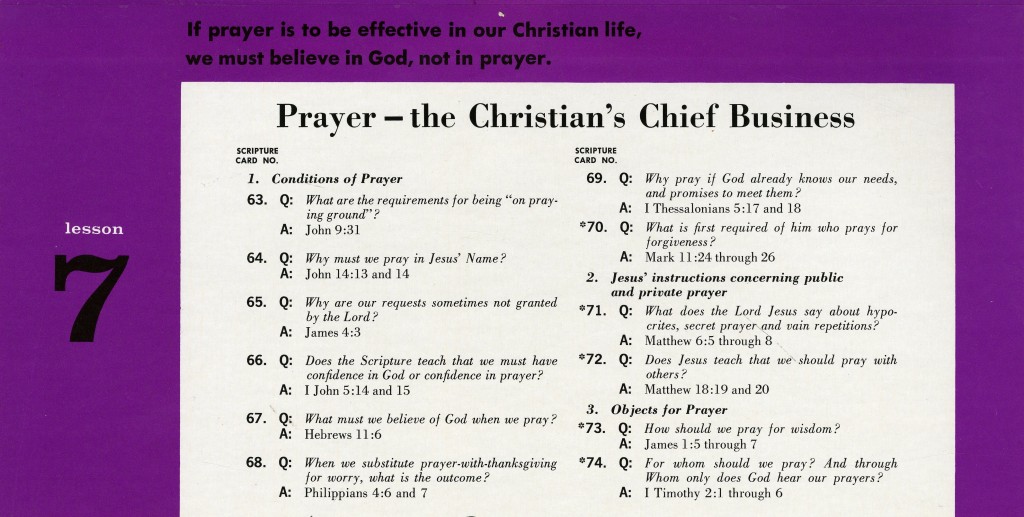
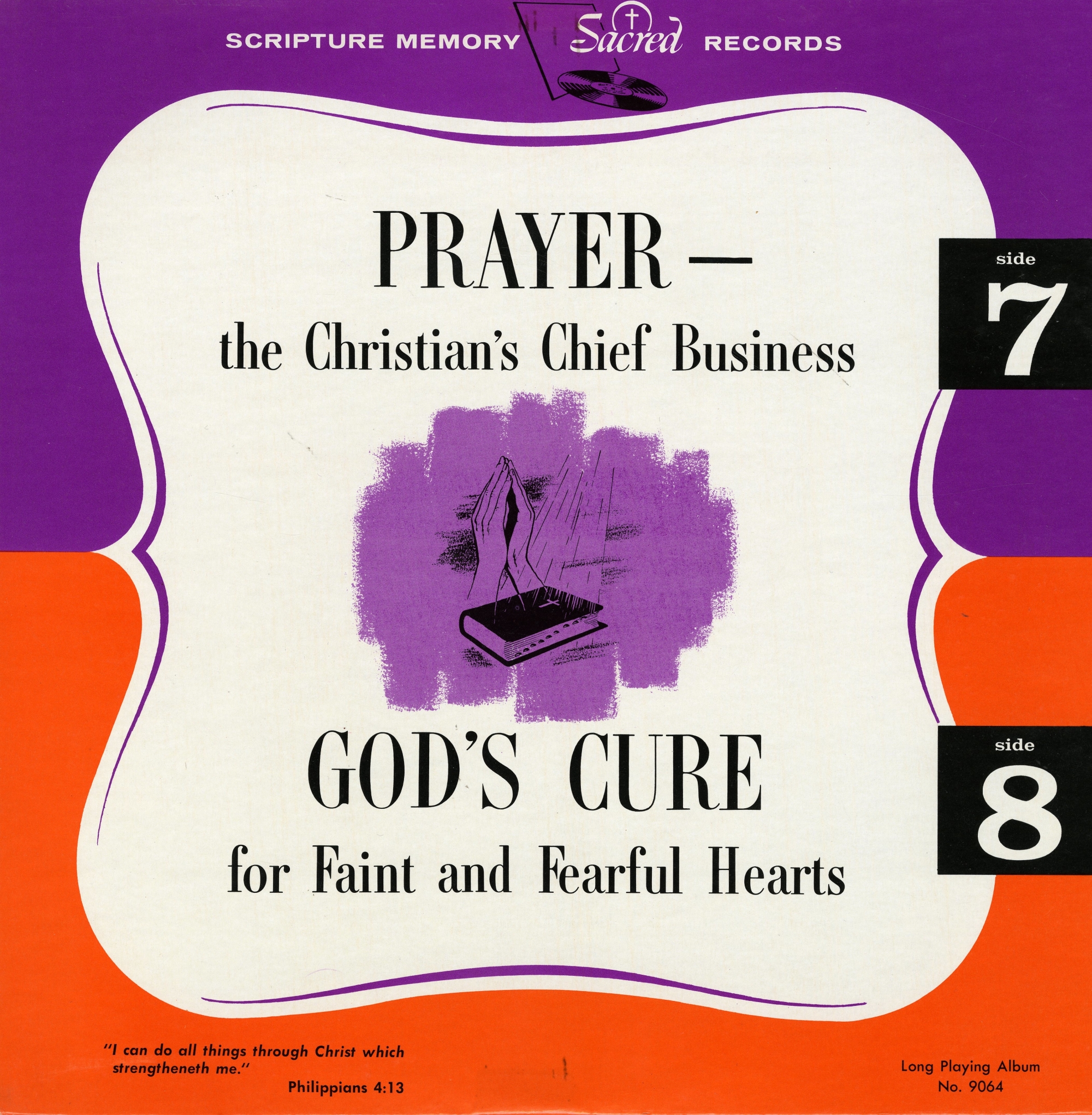



 One of the most important biblical references in the history of charismatic faith healing, the story of the woman with an “issue of blood” (Mark 5: 25-34), is often recounted to help explain the communication of curative efficacy from patient to healer. In this classic account of contagion, a woman with a seemingly incurable discharge of blood boldly makes her way through the dense throng following Jesus, reaching out her expectant hand to touch Jesus, the healer. Immediately upon contact with the “hem of his garment,” a healing virtue, or power, is communicated into the woman’s body. Both patient and healer simultaneously register this tactile contact: as the woman experiences a newfound sensation of somatic wellbeing, Jesus feels power leaving his body (see the above illustration from Oral Roberts’ famous
One of the most important biblical references in the history of charismatic faith healing, the story of the woman with an “issue of blood” (Mark 5: 25-34), is often recounted to help explain the communication of curative efficacy from patient to healer. In this classic account of contagion, a woman with a seemingly incurable discharge of blood boldly makes her way through the dense throng following Jesus, reaching out her expectant hand to touch Jesus, the healer. Immediately upon contact with the “hem of his garment,” a healing virtue, or power, is communicated into the woman’s body. Both patient and healer simultaneously register this tactile contact: as the woman experiences a newfound sensation of somatic wellbeing, Jesus feels power leaving his body (see the above illustration from Oral Roberts’ famous

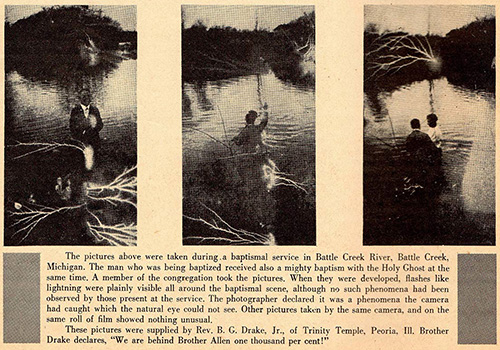
 Emphasizing their capacity to
Emphasizing their capacity to  On a basic structural level, the “loudspeaker” is itself a technical reproduction of glossolalia (unintelligible language), one of the most important forms of prayer in the Pentecostal tradition. Focusing upon technological terms such as “loudspeaker,”
On a basic structural level, the “loudspeaker” is itself a technical reproduction of glossolalia (unintelligible language), one of the most important forms of prayer in the Pentecostal tradition. Focusing upon technological terms such as “loudspeaker,” 
 Underneath the massive cloth architecture of Oral Roberts’ canvas cathedral, the “world’s first healing film” was screened for a crusade audience of over 10,000 on September 29th, 1952. Venture Into Faith is a compilation of actual archival footage shot earlier that year during a healing crusade in Birmingham, Alabama, woven seamlessly into highly produced scenes recorded in a Hollywood studio. The climax of the film, for example, features the miraculous cure of a tubercular boy named David through a performance of prayer. Although the actual performance of this healing prayer was performed by Oral Roberts and a group of professional actors, the final edited version of this spectacle of divine communication oscillates between “live” archival footage shot during a healing campaign and rehearsed “acting” recorded under the careful orchestration of a Hollywood director (1:23:39 in film).
Underneath the massive cloth architecture of Oral Roberts’ canvas cathedral, the “world’s first healing film” was screened for a crusade audience of over 10,000 on September 29th, 1952. Venture Into Faith is a compilation of actual archival footage shot earlier that year during a healing crusade in Birmingham, Alabama, woven seamlessly into highly produced scenes recorded in a Hollywood studio. The climax of the film, for example, features the miraculous cure of a tubercular boy named David through a performance of prayer. Although the actual performance of this healing prayer was performed by Oral Roberts and a group of professional actors, the final edited version of this spectacle of divine communication oscillates between “live” archival footage shot during a healing campaign and rehearsed “acting” recorded under the careful orchestration of a Hollywood director (1:23:39 in film).


